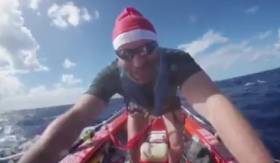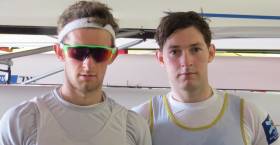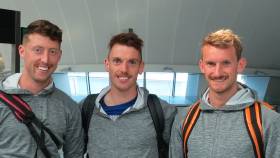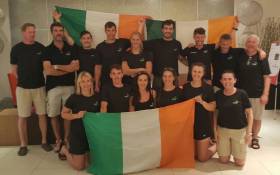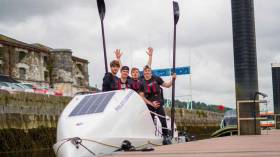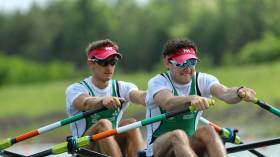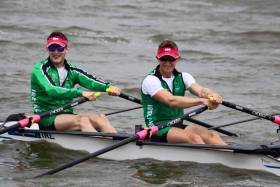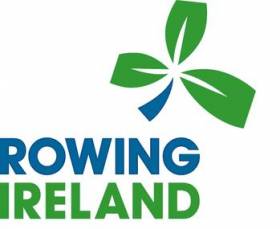Displaying items by tag: rowing
Browne 'Bloodied but Unbowed' after Capsize
#Rowing: Damian Browne twice capsized and suffered facial injuries but has continued to row in the Atlantic Challenge race. The Galway man, who competes as Gullivers Travels, posted a remarkable video on his Facebook page below telling of how he had been woken by his face “getting smashed off the side of the cabin”. He made light of the cut, which bled profusely, and the other injuries. The hours following brought another capsize and sighting of a whale which circled his boat and made eye contact with him. Browne and the two other boats from Ireland in the race, Relentless and Home to Portrush, are two weeks into the race from the Canary Islands to Antigua.
Christmas Cheer for Irish Atlantic Rowers
#Rowing: Christmas has been productive for the Relentless and Gullivers Travel crews taking part in the Atlantic Challenge rowing race. The four-man Relentless crew covered 84 nautical miles (156 kilometres) in the 24 hours to 4pm on St Stephen’s Day. They had rowed 993 nautical miles, and are set to pass the psychologically important 1,000 nautical-mile staging post today. They stand fourth of the fours and fifth overall.
Damian Browne, the solo oarsman who rows as Gullivers Travels, posted a Facebook message on Christmas Day. After tricky times early in the race he has locked in a steady race rhythm. He is 17th of the 21 boats at sea in the race from the Canary Islands to Antigua. Two crews, Team O2 and Team Tenzing had to be rescued in recent days after capsizes. The race organisers report that all the rowers are well.
Home to Portrush, a four, stands seventh overall.
Browne Prepares for Atlantic Row with Indoor Feat
#Rowing: Damian Browne set a remarkable time of 1:16.2 for 500 metres at the Provinces Indoor Rowing championships at the University of Limerick on Saturday. The big Galway man, who will row the Atlantic starting in December, finished second in the men’s open category. Colin Burke of Auriel Kensington won this with 1.4 seconds to spare over Browne.
Provinces Indoor Rowing Championships, Limerick,Saturday
Men, Open: 1 Colin Burke (Auriel-Kensington, London) 6:12.9, 2 Damian Browne 6:14.3, 3 Ciaran Brady (Offaly) 6:25.7. 500m: Browne 1:16.2
Junior 18 2000: Mark Ryder (Col Iognaid) 6:29.8.Jun 18 500: James McCarthy (CIT) 1:22.3
M J16 2000: Darragh Gallivan (CRCC) 6:52.8. Men, 30-39: John Whooley (Skib) 6:23.2.
M 40-49: Fintan Gilsenan (Castletownbere RC) 6:26.8.
Women, Open: B Larsen (Garda) 7:06.0. Jun 18 : Caoileann Nic Dhonncha (Col Iognaid) 7:34.1 Jun 16: Roisin O’Connor (Castleconnell BC) 7:34.7.
W 40-49: Fiona McKeown (Castleconnell BC) 7:23.0
Pararowing
MLTA: Kevin Wall (Clonmel) 6:51.9.
WLTA: Sarah McLoughlin (Univ of Limerick) 8:07.
Gary and Paul O'Donovan Second at Head of the Charles
#Rowing: Paul O’Donovan and Gary O’Donovan took second in the Championship Doubles at the Head of the Charles Regatta in Boston. The Skibbereen men pushed hard to close the gap on the first crew off, Penn Athletic Club, but the Americans won, by a very small margin.
Shannon won the Masters (40+) eights. The crew is a set of rowers who compete for the Limerick club to commemorate adventurer Eddie Crean, who died in a cycling accident in 2014.
Sanita Puspure and Magdalena Lobnig were to go off first in the women’s Championship Doubles, but they scratched. Puspure partnered Carling Zeeman in the double which finished fourth.
There was big news in the men's lightweight double: Jeremie Azou of France has announced his retirement. Azou partnered Pierre Houin to take gold in the Olympic Games - ahead of Gary and Paul O'Donovan.
Head of the Charles Regatta, Boston, Saturday (Unofficial; Irish interest)
Men
Masters Eights (40+): 1 Shannon 15:01
Championships Doubles: 1 Penn AC (J Keen, A Frid) 16 min 35.304, 2 Skibbereen (G O’Donovan, P O’Donovan) 16:35.428; 7 Skibbereen (M O’Donovan, S O’Driscoll) 17:15.333.
Ireland's Golden Boys Set To Return after World Rowing Championships
#Rowing: The Ireland gold medallists Mark O’Donovan and Shane O’Driscoll and Paul O’Donovan are due to arrive back in Ireland tomorrow (Sunday). They are due in Dublin Airport at about 10 o’clock. They will travel to Skibbereen for a special event in the evening.
Gary O’Donovan, who took a silver medal at the Olympic Games but missed the World Rowing Championships in Florida through illness, will also be flying in.
Ireland Team the Afloat Rowers of the Month for September
#Rowing: The Ireland team which brought the country glory at the World Rowing Championships in Florida are the Afloat Rowers of the Month for September. In that month, Ireland took two gold medals through Mark O’Donovan and Shane O’Driscoll in the lightweight pair and Paul O’Donovan in the lightweight single sculls.
The pair crowned the perfect season with their victory. They won gold at the three World Cup regattas and the European Championships. The pressure was on in World Championship final, with both Brazil and Italy rowing well on the day. But O’Donovan and O’Driscoll were peerless. They set a very high stroke rate, took the lead – and saw off their challengers.
Paul O’Donovan retained the title he had taken with such an extraordinary set of performances in Rotterdam in 2016, just weeks after he had taken a silver at the Olympic Games in a lightweight double with his brother Gary. This time, Gary had to drop out of the lightweight double, as illness had restricted his training (he supported the team as a reserve). Paul was back in the lightweight single in a boat which was new to him. He won all four races (heat, quarter-final, semi-final and final), seeing off a new set of challengers in the lightweight single, including Matthew Dunham of New Zealand, who took silver, and Kris Brun of Norway (bronze).
The rest of the Ireland team also gave the suppporters plenty to shout about. Sanita Puspure went on to take fourth in the single sculls and Denise Walsh reached the A Final of the lightweight single sculls, where she finished sixth. Two new heavyweight pairs gained experience of the top level as the team targets Tokyo 2020. Aileen Crowley and Aifric Keogh finished eighth and there was a 16th place for Patrick Boomer and Fionnán McQuillan-Tolan.
Well done to all the members of the Ireland team, the Afloat Rowers of the Month for September.
Rower of the Month awards: The judging panel is made up of Liam Gorman, rowing correspondent of The Irish Times, and David O'Brien, editor of Afloat magazine. Monthly awards for achievements during the year will appear on afloat.ie. Keep a monthly eye on progress and watch our 2017 champions list grow.
Cork University Hospital (CUH) is to receive vital funds as four Irish men compete in a 5,500km (3,000 nautical miles) rowing challenge across the Atlantic on December 12th to raise over €20,000 for the hospital’s Children’s Unit. The team, dubbed the ‘Relentless Rowers’, hopes to break the current world record by completing the Talisker Whiskey Challenge from the Canary Island of La Gomera to the Caribbean island of Antigua in under 35 days.
If successful, the group comprising of junior doctors Seán Underwood and Patrick O’Connor, Cork-based podiatrist Eoin O’Farrell and young Dublin entrepreneur Thomas Browne, will also be the first all-Irish four-man crew to complete the challenge. Funds raised will go to the CUH Children’s Unit. To make a donation, visit www.relentless.ie.
The Talisker Whisky Atlantic Challenge is known as the world’s toughest row, and the team will take part in a specially-designed small 28ft ocean rowing boat, named Saoirse. They will receive no outside assistance and no re-supplies of food, drink or equipment during the race, surviving solely on what’s on-board.
Speaking about the upcoming challenge, Miriam Forde, CUH Charity said: “Everyone at CUH is extremely excited for the team, and we wish them the best of luck as they take on one of the world’s most difficult challenges. Their efforts will have a significant impact on our services and facilities in our Children’s Unit at CUH, which will directly affect the level of care that we can provide to our youngest patients and their families.”
Sean Underwood added: “Fewer people have crossed the Atlantic than have climbed Everest, so we’re well aware of the challenge we’re undertaking, but quite simply, we believe that you only get one shot at life, everybody dies but not everybody lives.
“In the hospitals we work in, we are faced almost daily with the fragility of the human condition. To put a dream on hold in the hope of affording a better time to do it is a dangerous thing. Life fleets past us. There is and will never be a ‘good’ time to row an ocean, so we’re acting on our dreams here and now.
“If we can make a difference to just one child in the CUH Children’s Unit by competing in this race, then it will all have been worth it.”
While their primary goal is to raise funds for the Children’s Unit at CUH, the team is also hoping to raise awareness for suicide prevention charity Pieta House.
Ireland's World Rowing Team Announced
The Ireland team for the World Rowing Championships includes a men's and women's pair which were trialled this week. Fionnan McQuillan-Tolan and Patrick Boomer form the men's heavyweight pair and Aifric Keogh and Aileen Crowley the women's. The team is backboned by the lightweight crews which had a wonderful run at the World Cup Regattas and European Championships this season.
The Championships will be held in Florida in September/October.
Ireland team for World Rowing Championships, Florida, September/October
Men:
Lightweight double: Gary O’Donovan (Skibbereen RC)/ Paul O’Donovan (Skibbereen RC) LIghtweight Pair: Mark O’Donovan (Skibbereen RC)/ Shane O’Driscoll (Skibbereen RC)Pair: Patrick Boomer (Belfast RC)/ Fionnan McQuillan-Tolan (NUIG BC)
Women:
Single Sculls: Sanita Puspure (Old Collegians BC)
LIghtweight Single: Denise Walsh (Skibbereen RC)Pair: Aileen Crowley (UCD BC)/ Aifric Keogh (UCC RC)
Coaches: Dominic Casey, Sean Casey
Team Manager: Susan Dunlea
Repechage Win Eases O'Donovans Into European Semi-Finals
#Rowing: Paul and Gary O’Donovan won their repechage to secure a place in the semi-finals of the lightweight double sculls at the European Rowing Championships in Racice today. The Irish crew did not start well, but by halfway they were making their move and they led through the second half of the race. As they passed the grandstand, they came under pressure from the Ukraine, but they held firm and won by a length.
European Championships, Racice, Czech Republic, Day One (Selected Results; Irish interest)
Men
Lightweight Pair – Exhibition (Race for Lanes): 1 Ireland (M O’Donovan, S O’Driscoll) 6:57.77, 2 Italy 6:59.82, 3 Russia 7:01.75, 4 Britain (J Cassells, S Scrimgeour) 7:03.39.
Lightweight Double Sculls – Heats (Winner to A/B Semi-Finals; rest to Repechages) – Heat One: 1 France (P Houin, J Azou) 6:26.97. Heat Two: Germany (L Schaefer, J Osborne) 6:37.53.
Heat Three: 1 Poland 6:25.93, 2 Ireland (G O’Donovan, P O’Donovan) 6:32.15, 3 Russia 6:36.38, 4 Switzerland 6:40.60, 5 Austria. Heat Four: 1 Italy 6:30.77.
Repechage Three (First two to A/B Semi-Finals): 1 Ireland 6:34.33, 2 Ukraine 6:36.51; 3 Portugal 6:40.75, 4 Sweden 7:05.89.
Women
Lightweight Single Sculls – Heat One (First Three to Semi-Finals; rest to Repechage): 1 Ireland (D Walsh) 7:44.85, 2 Denmark (A Runge Holmegaard) 7:49.49, 3 Poland (J Dorociak) 7:49.90; 4 Czech Republic 8:05.07, 5 Portugal 8:08.19. Heat Two: 1 Switzerland 7:42.510. Heat Three: 1 Sweden 7:39.52.
#Rowing: The new High Performance Director for Irish rowing will be Antonio Maurogiovanni. The Italian will take up the role in August.
Maurogiovanni rowed for Italy at the 1988 Seoul and 1992 Barcelona Olympic Games in the four and eight respectively.
As a coach he was involved in seven Olympic Games with several nations including Italy, the Netherlands, and Australia. He moves on from his role with Rowing Australia as Head Coach with the Western Australian team after 15 years. He said he was excited to take up the new challenge.
He said rowing has been his passion and made up much of his life. “It has taken me from Italy to Australia to the Netherlands and back to Australia and now to Ireland. I look forward to applying the experience and knowledge I have acquired over the years and using it to the best of my ability to bring success in Ireland.”
Hamish Adams, the chief executive of Rowing Ireland, said: “We have been through an extremely robust and intensive recruitment process to source the best possible candidate for this demanding role. As a professional coach with a background in sport science and vast Olympic experience Antonio is an exceptional candidate and we are delighted to welcome him to our team.
“I wish to thank Neville Maxwell, Chair of our High Performance Committee, Paul McDermott, Sport Ireland High Performance Director and Gianni Postiglione, World Rowing (FISA) coaching representative for their personal contributions to this recruitment process."



























